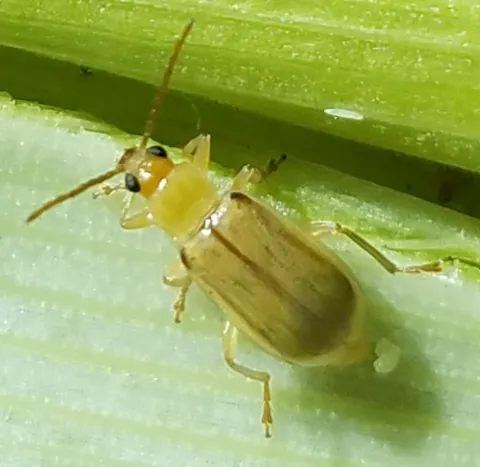Crop rotation
Crop rotation is the No. 1 strategy for managing corn rootworm populations because it disrupts the year-to-year availability of corn, their primary host plant. Crop rotation also can help slow the development of resistance to other control tactics.
NDSU Extension encourages crop rotation with nonhost crops, such as soybean, flax, sunflower, or wheat. Corn rootworms mainly depend on corn as a food plant, and larvae usually will starve to death on all but a few noncorn plants. As such, crop rotation with nonhost crops can effectively break the link of the corn rootworm life cycle.
Adaptations of Corn Rootworms to Crop Rotation
Northern and western rootworm populations have adapted to crop rotation systems; however, each has adapted by a different mechanism.
The northern corn rootworm has adapted to crop rotation through extended egg diapause (the dormant period), in which some eggs remain in diapause for two or more winters. If corn is rotated annually with soybeans or another nonhost crop, extended-diapause eggs will hatch in the subsequent spring when corn is planted again in the field.
Northern corn rootworm populations with extended egg diapause occur in Minnesota, South Dakota, Iowa, Wisconsin and Nebraska. However, this adaptation has not been researched in North Dakota.
Some western corn rootworm populations have shown a behavioral shift, in which variant females in regions with intensive, near universal use of a corn/soybean rotation will lay eggs in soybean fields as well as corn fields. The eggs laid in soybean fields then hatch during the following growing season when the rotation returns to corn.
The behavioral shift by these western corn rootworm-variant females has been observed in Illinois, Indiana, Michigan and Ohio. Soybean-variant western corn rootworm populations have not been reported in North Dakota to date.
Control of Volunteer Corn
Volunteer corn or other grassy weeds growing in other rotational field crops such as soybean can be attractive to localized corn rootworm beetle infestations for egg laying or feeding on silks, leaves, or pollen. Females from North Dakota corn rootworm populations most likely will not lay eggs in fields without corn.
Planting Date Modification
Early planted corn typically produces more vigorous root systems and higher yields. However, early planted corn can also result in early silk development and pollination and, in turn, allow these processes to occur before peak corn rootworm adult emergence. This can minimize the risk or extent of silk clipping and pollination interference by beetles.
In contrast, late-planted corn leads to later corn silk development and pollination, thus placing such fields at higher risk of significant silk clipping and kernel feeding injury. Late-planted fields also will be more attractive for egg laying by corn rootworm beetles, and therefore can be at increased risk of larval feeding injury during the subsequent growing season.





















